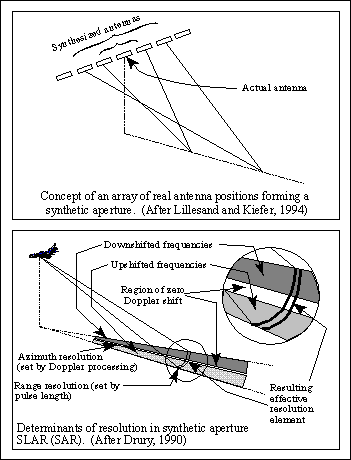![]()
Designing and constructing an instrument capable of desirable resolution is not always possible. The following examples (from Lillesand and Kiefer, 1994) illustrate this point.
If a wavelength of 5 cm. (0.05 m.) is used, to obtain a resolution of 10 millirads (solving for AL), an antenna would have to be 5 meters long.
Using the same wavelength, should an enhanced resolution, of 2 millirads be required (solving for AL), the antenna would have to be 25 meters long!
Obviously, this is impractical if not physically impossible.
![]()
The "Very Large Array" (VLA) near Socorro, New Mexico operates on this principle. The concept behind the construction of this radio observatory and the design of synthetic aperture radars are quite similar. The VLA uses several strategically located physical radio dishes to simulate one very large antenna. An SAR uses only one antenna, but since the antenna is in motion, its changing position through time duplicates the effect of several physical antennas spread out in a virtual "row."

The motion of the synthetic aperture radar platform provides the instrument with the necessary spatial displacement for the antenna to "appear" much larger after special data recording and processing techniques are employed. A 2 meter-wide antenna can actually simulate on that is several hundred meters long!
As can be seen in the diagram (top), as the ground range from the physical antenna increases, the "virtual antenna length" also increases. As a result, the azimuth resolution (Ra) remains constant, independent of ground range.
Another explanation for the improved azimuth resolution of synthetic aperture radar involves the minute Doppler shifts in reflected microwaves in front and in back of the airplane (bottom). Radar waves will be slightly "upshifted" (of a slightly shorter wavelength) in the region just ahead of the aircraft, and slightly "downshifted" (of a slightly longer wavelength) in the region just behind the aircraft. A very narrow band of zero Doppler shift defines the adjusted azimuth resolution.
![]() Return to the Radar Mapping Home Page
Return to the Radar Mapping Home Page
![]() Return to Hunter's Terrain Analysis Home Page
Return to Hunter's Terrain Analysis Home Page